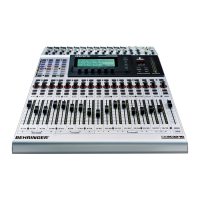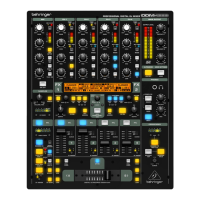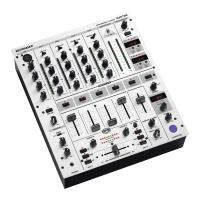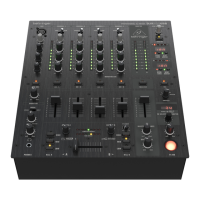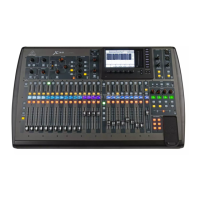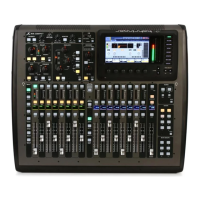47
14.1 AES/EBU
The AES/EBU interface (Audio Engineering Society and
European Broadcasting Union) is mainly used in professional
studio environments and broadcasting applications for the
transmission of digital signals over greater distances. The
connections are made using balanced XLR cables with a specific
cable resistance of 110 ohms. The cables may be 300-1500 feet
long. With some minor adaptations even cable lengths of more
than 0.5 miles are possible, which is not unusual in TV and
broadcasting applications.
The interface complies with the AES3 format, which allows
for the two-channel transmission of signals with a resolution of
up to 24 bits. The signals are auto-clock and auto-sync, which is
important for the connection of multiple digital devices. So, there
is no need for an additional wordclock connection between the
DDX3216 and connected AES/EBU equipment. The sampling rate
is not fixed, and can be selected freely. Typical sampling rates
are 32 kHz, 44.1 kHz and 48 kHz. The AES/EBU interface is
largely compatible with the S/PDIF interface widely used in semi-
professional applications. The connection can be made using a
specific adapter. However, as there are some differences in
terms of data structure and electrical specifications, we do not
recommend the use of such a connection.
Type AES/EBU IEC 958 (S/PDIF)
Connection XLR RCA/optical
Mode of operation balanced unbalanced
Impedance 110 ohms 75 ohms
Level 0.2 V to 5 V pp 0.2 V to 0.5 V pp
Clock accuracy not defined
I: ± 50 ppm II: 0.1 %
III: variable pitch
Jitter ± 20 ns not defined
Tab. 14.2: AES/EBU and S/PDIF specifications
14.2 ADAT
®
The ADAT
®
-Multi-Channel-Optical-Digital format was developed
by ALESIS
®
company, and has been implemented both in digital
recorders of different brands and in effects devices,
synthesizers, hard-disk recording systems and computer
interfaces. Meanwhile, plenty of peripherals are available for
this interface, such as microphone preamplifiers, external A/D
and D/A converters, etc. And you can also retrofit your DDX3216
with an ADAT
®
-based interface.
The ADAT
®
format transmits eight digital channels simul-
taneously via optical plastic cables. Professionals often refer to
this interface standard as “lightpipe”, because of the optical
connection, which can even be seen: just send a signal over the
cable and look at the other end of the cable!
The data format supports signals with a resolution of max. 24
bits and a sampling rate of 48 kHz (standard configuration—
deviations are possible due to pitch shifting). The data stream is
auto-clock, i. e. the DDX3216 can clock equipment connected to
its ADAT
®
interface, or can be clocked by an ADAT
®
device
providing a wordclock signal. An additional word clock
connection is not required.
14.3 TDIF-1
The TDIF-1 digital audio format was developed by TASCAM
®
company (current version: 1.1). Here, too, eight digital tracks can
be transmitted at the same time. The maximum sampling rate is
48 kHz, the maximum signal resolution 24 bits. TDIF-1 connections
are made with 25-pin D-Sub connectors. The cable length should
not exceed 5 meters. Signals can be synchronized via the TDIF-1
interface, even though TASCAM
®
recommends an additional word
clock connection. The first generation of TASCAM
®
DA-88
recorders is an exception to this rule, as these DTRS
®
recorders
do not allow for selecting the digital input as a clock source.
+ The DDX3216 can only transmit, but not receive word
clock signals via its TDIF interface. For this reason,
the DDX3216 must always be configured as the
“master”. If you wish to define a connected TDIF
device as “master”, you will need to establish an
additional wordclock connection.
14. EXPANSIONS

